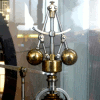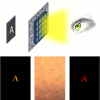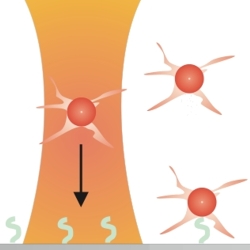-
Viewpoint on 'IONS'
Viewpoint on 'Scientific Literacy'
- Proudly sponsored by
-


-
EPS QEOD Thesis Prizes: The Winners of 2011

Six young scientists have received the prestigious QEOD Thesis Prize, awarded by the Quantum Electronics and Optics division (QEOD) of the European Physical Society (EPS). Congratulations!
-
Quantum Circuits: Fast and Cool

In the 20th century information technologies based on microelectronics changed the world. In the 21st century nanophotonics looks very likely to become a key factor in the building of quantum information technologies.
-
Outclassing Superheroes

Superheroes, watch out! A new rival, such as you have never come up against before, is in town. Progress is the name! And the exclusivity of your superpowers may well be at stake.
Volume 3 Story 1 - 6/10/2008

Quantum dots are extremely small nanocrystals ranging between 2 and 10 nanometers – only a few tens of atoms – in diameter. Thanks to their small size their properties are different from the properties of the bulk material of which they are made. At the same time, however, their small size is what makes manipulating them and studying them tremendously challenging. Now the group led by Lene Oddershede at Niels Bohr Institute (Copenhagen, Denmark) has demonstrated that it is possible to trap and manipulate a single quantum dot using a relatively low power continuous-wave optical trap.
An optical trap is generated by a focused laser beam. Typically a micrometer-sized particle is attracted to the high-intensity region of the focus. It is well known from quantum mechanics that light carries a momentum: for a photon of wavelength λ the associated momentum is p = h/ λ, where h is the Planck constant. This is why when an atom emits or absorbs a photon its momentum changes in accordance with Newton’s laws. Analogously, when a light beam is refracted or reflected by a particle, this particle will experience some force. Most particles tend to move towards the high intensity regions because they have a high refractive index. The ability of light to exert forces has been recognized for quite some time: back in 1619 Kepler described the deflection of comet tails by the sun’s rays [1]. However, these forces are so small that only in recent years, and only thanks to the advent of the laser, has it been possible to concentrate, in a small area, enough optical power to trap microscopic particles.
However, optical forces are still extremely small, and they have to constantly fight against the Brownian motion – the random walk that shakes every microscopic object immersed in a fluid. The further down to smaller particles we move, the harder this fight becomes. In fact, the optical forces decrease with the size of the particle, while the Brownian motion gains in strength. That is why a higher optical power is needed to trap smaller particles; before Oddershede’s work, it had been proposed that 20 watts of power would be needed to trap a 10-nanometer quantum dot [2]. Such power is huge when it is focused down on a square micron area – 20 terawatts per square meter, that is, about 20 billion times less than the sun power that reaches the Earth at midday (1300 watts per square meter).
Oddershede and colleagues managed to trap and manipulate a quantum dot using only 100 milliwatts laser power at the sample. A full spectrum of applications can, therefore, be envisioned. For example, "optically trapped quantum dots can be used to manipulate anything that is too small to be moved by itself," observes Oddershede. "This opens up a wealth of opportunities in single molecule studies."
Biomolecules and molecular motors are ubiquitous in biology, and they are responsible for cell locomotion and intracellular transport. These have been studied using optical traps since the early 1990s. The problem is that biomolecules are far too small and complex to be optically trapped. That is why in single molecule experiments a relatively large – micrometer-sized – particle is used to handle the molecule and a fluorophore is used to see it. With an optically trapped quantum dot, which is orders of magnitude smaller than the particle, it will be possible to handle the molecule and see it at the same time. When illuminated by a laser beam, quantum dots emit light at a frequency that is extremely sensitive to both the dot’s size and composition. Therefore they are often used as nanometer-sized beacons to track down small objects such as biomolecules. One advantage of quantum dots over other fluorophores is that they are much smaller, more stable, and they typically have a higher yield.
The idea to try to trap a single quantum dot came to Oddershede and colleagues while they were studying a DNA-polymerase to which a quantum dot was attached. "We wanted to trap and visualize the molecule using the quantum dot itself," explains Oddershed, "normally, we would have needed a bead to handle it and a fluorophore to be able to localize it. We thought it may be possible with our instruments to also trap quantum dots, since we had experience in trapping small particles: a few months before we had also trapped nanorods 8 by 22 nanometers in size."
In a completely different field Oddershede’s experiment paves the way to the physical characterization of quantum dots, which is still challenging due to their small size. "One thing I like about this experiment," explains Oddershede, "is that it can give information about how the quantum dot interacts with the optical field. This can be used to study the physical properties of a single quantum dot, obtaining in this way information that nowadays is only available for bulk measurements."
The fact that quantum dots can be optically trapped does not come completely unexpected to Alexander Rohrbach from the Albert-Ludwigs-Universität (Freiburg, Germany). In fact, it is well established that, to a certain extent, it is enough to raise the laser power to trap small objects, such as quantum dots. Nevertheless, it is interesting to know that they can be trapped using only 100 milliwatts and this is a line of research that certainly deserves to be pursued.
[1] J. Kepler, De Cometis Libelli Tres, 1619.
[2] L. Pan et al., Detection of optical trapping of CdTe quantum dots by two-photon-induced luminescence, Phys Rev B 75, 161305 (2007).

A Nano-Firefly in the Trap
Fireflies emit pulses of light that allow them to be localized. Quantum dots behave in the same way albeit at the nanoscale. Now they can be manipulated using a relatively low power optical trap.
A quantum dot in an optical trap. A single quantum dot can be trapped and manipulated by an optical tweezers. Credit: Lene Oddershede.
An optical trap is generated by a focused laser beam. Typically a micrometer-sized particle is attracted to the high-intensity region of the focus. It is well known from quantum mechanics that light carries a momentum: for a photon of wavelength λ the associated momentum is p = h/ λ, where h is the Planck constant. This is why when an atom emits or absorbs a photon its momentum changes in accordance with Newton’s laws. Analogously, when a light beam is refracted or reflected by a particle, this particle will experience some force. Most particles tend to move towards the high intensity regions because they have a high refractive index. The ability of light to exert forces has been recognized for quite some time: back in 1619 Kepler described the deflection of comet tails by the sun’s rays [1]. However, these forces are so small that only in recent years, and only thanks to the advent of the laser, has it been possible to concentrate, in a small area, enough optical power to trap microscopic particles.
However, optical forces are still extremely small, and they have to constantly fight against the Brownian motion – the random walk that shakes every microscopic object immersed in a fluid. The further down to smaller particles we move, the harder this fight becomes. In fact, the optical forces decrease with the size of the particle, while the Brownian motion gains in strength. That is why a higher optical power is needed to trap smaller particles; before Oddershede’s work, it had been proposed that 20 watts of power would be needed to trap a 10-nanometer quantum dot [2]. Such power is huge when it is focused down on a square micron area – 20 terawatts per square meter, that is, about 20 billion times less than the sun power that reaches the Earth at midday (1300 watts per square meter).
Oddershede and colleagues managed to trap and manipulate a quantum dot using only 100 milliwatts laser power at the sample. A full spectrum of applications can, therefore, be envisioned. For example, "optically trapped quantum dots can be used to manipulate anything that is too small to be moved by itself," observes Oddershede. "This opens up a wealth of opportunities in single molecule studies."
Biomolecules and molecular motors are ubiquitous in biology, and they are responsible for cell locomotion and intracellular transport. These have been studied using optical traps since the early 1990s. The problem is that biomolecules are far too small and complex to be optically trapped. That is why in single molecule experiments a relatively large – micrometer-sized – particle is used to handle the molecule and a fluorophore is used to see it. With an optically trapped quantum dot, which is orders of magnitude smaller than the particle, it will be possible to handle the molecule and see it at the same time. When illuminated by a laser beam, quantum dots emit light at a frequency that is extremely sensitive to both the dot’s size and composition. Therefore they are often used as nanometer-sized beacons to track down small objects such as biomolecules. One advantage of quantum dots over other fluorophores is that they are much smaller, more stable, and they typically have a higher yield.
The idea to try to trap a single quantum dot came to Oddershede and colleagues while they were studying a DNA-polymerase to which a quantum dot was attached. "We wanted to trap and visualize the molecule using the quantum dot itself," explains Oddershed, "normally, we would have needed a bead to handle it and a fluorophore to be able to localize it. We thought it may be possible with our instruments to also trap quantum dots, since we had experience in trapping small particles: a few months before we had also trapped nanorods 8 by 22 nanometers in size."
In a completely different field Oddershede’s experiment paves the way to the physical characterization of quantum dots, which is still challenging due to their small size. "One thing I like about this experiment," explains Oddershede, "is that it can give information about how the quantum dot interacts with the optical field. This can be used to study the physical properties of a single quantum dot, obtaining in this way information that nowadays is only available for bulk measurements."
The fact that quantum dots can be optically trapped does not come completely unexpected to Alexander Rohrbach from the Albert-Ludwigs-Universität (Freiburg, Germany). In fact, it is well established that, to a certain extent, it is enough to raise the laser power to trap small objects, such as quantum dots. Nevertheless, it is interesting to know that they can be trapped using only 100 milliwatts and this is a line of research that certainly deserves to be pursued.
[1] J. Kepler, De Cometis Libelli Tres, 1619.
[2] L. Pan et al., Detection of optical trapping of CdTe quantum dots by two-photon-induced luminescence, Phys Rev B 75, 161305 (2007).
Giovanni Volpe
2008 © Optics & Photonics Focus
GV is currently working on his doctoral thesis at ICFO - The Institute of Photonic Sciences, Barcelona (Spain).

Liselotte Jauffred, Andrew C. Richardson, and Lene B. Oddershede, Three-Dimensional Optical Control of Individual Quantum Dots, Nano Letters (2008) , (link).